Suzuki HP-275E, HP-175E User Manual
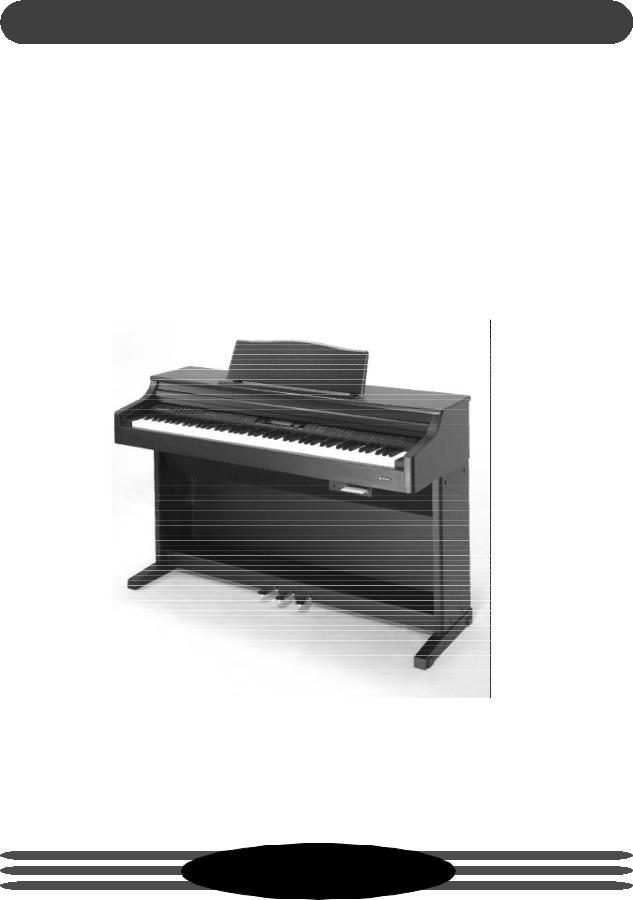
SUZUKI Pianos
HP-275e
HP-175e
COMPOSER ENSEMBLE
OWNER’S MANUAL
SUZUKI
1

2
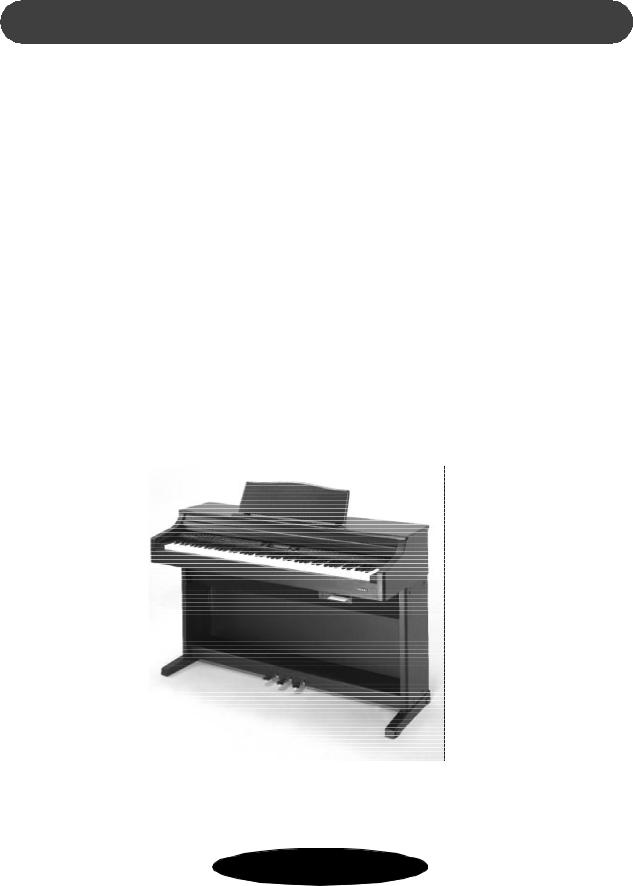
WELCOME!
We would like to express our appreciation and congratulate you for purchasing this Suzuki composer ensemble piano. This piano has been designed to provide you with years of musical enjoyment. State of the art electronics are combined with an elegant cabinet that will add beauty and sophistication to any home environment. Some of the features your new piano is equipped with include:
whammer action piano for an authentic acoustic piano feel
w128 true binaural stereo sampled voices for ultra authentic acoustic sound
w64 note polyphony
wa dynamic 8 speaker concert hall sound delivery system with EQ controls
wLCD display screen for user friendly controls
wbuilt-in play along songs for your learning and enjoyment
weasy 5 track recording capabilities
wkaraoke display and floppy disk drive (HP-275e only)
wcomplete MIDI controls
You will find many more features and functions listed within this owners manual. In order to fully appreciate all the unique features of this digital piano, please take a few minutes to read the following pages of instruction. We will cover general precautions, assembly, the function of each control button, and warranty information.
Thank you and congratulations again, for choosing this composer ensemble piano from the Suzuki Corporation’s piano product line of portable pianos, home digital pianos, home composer ensebles pianos, elegant digital grand ensembles, and the acoustic upright and grand
piano models.
SUZUKI
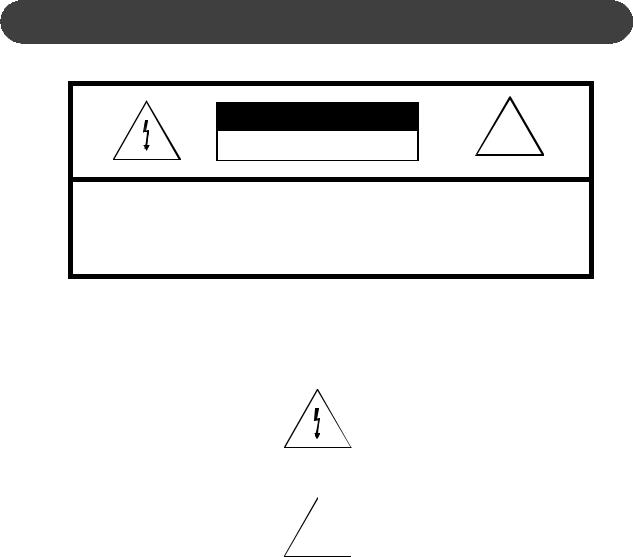
GENERAL PRECAUTIONS
CAUTION |
! |
|
RISK OF ELECTRIC SHOCK |
||
|
||
DO NOT OPEN |
|
CAUTION: TO REDUCE THE RISK OF ELECTRIC SHOCK,
DO NOT REMOVE COVER OR BACK
NO USER-SERVICEABLE PARTS INSIDE
REFER SERVICING TO QUALIFIED SERVICE PERSONNEL
INSTRUCTIONS PERTAINING TO A RISK OF FIRE, ELECTRIC SHOCK OR INJURY:
The lightning flash with arrowhead symbol, within an equilateral triangle, is intended to alert the user to the presence of uninsulated or “dangerous voltage” within the product’s enclosure that may be of sufficient magnitude to constitute a risk of electric shock to persons.
The exclamation point within an equilateral triangle is intended to alert the user to the presence of important operation and maintenance or servicing instructions.
!
1.CAUTION: Any changes or modifications in construction of this device which are not expressly approved by the party responsible for compliance could void the user’s authority to operate the equipment.
2.NOTE: This equipment has been tested and found to comply with the limit for a Class A digital device, pursuant to part 15 of the FCC rules. These limits are designed to provide reasonable protection against harmful interference when the equipment is operated in a noncommercial environment. This equipment generates, uses, and can radiate radio frequency energy and if not installed and used in accordance with the instruction manual, may cause harmful interference to radio communications. Operation of this equipment in a residential area is likely to cause harmful interference in which case the user will be required to correct the interference at his own expense.

TAKING CARE OF YOUR DIGITAL PIANO
This Suzuki digital piano will supply you with years of musical enjoyment if you follow the simple rules listed below.
SERVICE AND MODIFICATION
This product should be serviced by qualified service personnel when,
w the power supply cord or the plug has been damaged,
w liquid has been spattered into the unit or it has been exposed to rain,
w the instrument does not appear to operate normally or exhibits a marked change in performance or
w the instrument has been dropped or the cabinet has been damaged.
w Do not attempt to open the piano or make any change in the circuits or parts of the unit.
HANDLING AND TRANSPORT
w Never apply excessive force to the controls, connectors or other parts of the instrument.
w Always unplug cables by gripping the plug firmly, not by pulling on the cable.
w Disconnect all cables before moving the instrument.
w Physical shocks caused by dropping, bumping, or placing heavy objects on the instrument can result in scratches and/or more serious damage.
w Carefully check the amplifier volume control before starting to play. Excessive volume can cause permanent hearing loss.
CLEANING
w Clean the cabinet and panel with a soft dry cloth. A wax based polish may be used on the cabinet, although rubbing with a soft cloth will usually suffice. Do not use paint thinner or petrochemical based polishes.
w To maintain the luster of the keys and buttons wipe with a clean, slightly damp cloth, and then polish with a soft dry cloth.
LOCATION
Do not expose the instrument to the following conditions to avoid deformation,
discoloration, or more serious damage, w direct sunlight (near a window),
w high temperatures (near a heat source, outside, or in a car during the daytime),
w excessive humidity, w excessive dust or w strong vibration.
w Leave enough space around the piano for it to be properly ventilated.
w This instrument contains digital circuitry and may cause interference if placed too close to radio or television receivers. If interference occurs, move the instrument further away from the affected equipment.
w Avoid placing vinyl objects on top of the instrument, vinyl can stick to and discolor the surface.
POWER
w Turn the power switch off when the instrument is not in use.
w To avoid damage to the instrument and other devices to which it is connected, turn the power switches of all related devices off prior to connection or disconnection of MIDI cables.
w Turn the power off if the main cable is damaged or the instrument is spattered with liquid.
w Do not switch the unit on and off in quick succession, this places an undue load on the electronic components.
w Unplug the AC power cord during an electrical storm.
w Avoid plugging the AC adaptor into the same AC outlet as appliances with high power consumption, such as electric heaters or ovens.
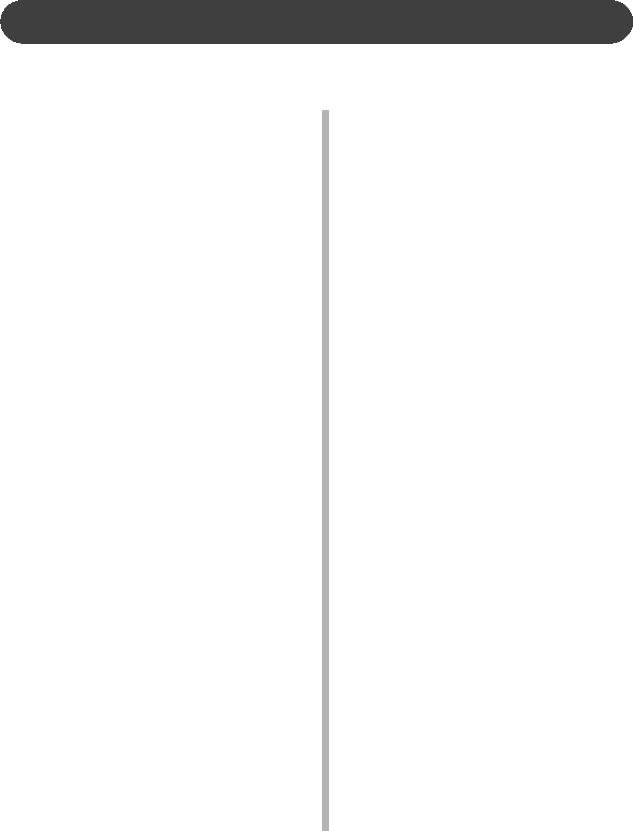
TABLE OF CONTENTS
EASY SET UP AND QUICK PLAY .............. |
7 |
ASSEMBLY .................................................. |
8 |
CONNECTOR PANELS ........................... |
12 |
PANEL CONTROLS .................................. |
13 |
DISK DRIVE .............................................. |
24 |
PEDALS .................................................... |
25 |
DISPLAY SCREEN.................................... |
26 |
DEMO ........................................................ |
27 |
PIANO VOICES.......................................... |
28 |
Assigning a Mode .................................... |
28 |
Voice Selection ........................................ |
29 |
Quick Select ............................................. |
31 |
RHYTHM SECTION ................................... |
33 |
Rhythm Style Select .................................. |
33 |
Quick Select ............................................. |
34 |
Starting and Stopping the Rhythm Style .... |
36 |
Fill-In ........................................................ |
37 |
Fill to Variation.......................................... |
37 |
Fade ........................................................ |
37 |
Adjusting the Tempo ................................. |
38 |
One Touch ................................................ |
38 |
AUTO ACCOMP. (AUTO BASE CHORD) .. |
39 |
One Finger ............................................... |
41 |
Fingered .................................................. |
42 |
Piano ....................................................... |
43 |
Manual Bass Chord .................................. |
43 |
Starting and Stopping the Auto Accomp... |
44 |
Fill-In ........................................................ |
45 |
Fill to Variation.......................................... |
45 |
Fade ........................................................ |
45 |
SET UP ....................................................... |
46 |
Performance |
|
Velocity ............................................... |
47 |
Split Point ........................................... |
47 |
Transpose ........................................... |
48 |
Screen Hold ........................................ |
48 |
Tune .................................................... |
49 |
Fixed Level ......................................... |
49 |
Fade Time .......................................... |
50 |
Octave Shift ........................................ |
50 |
SETUP continued |
|
Harmony ................................................... |
51 |
Key Mode |
|
Manual Bass ....................................... |
52 |
Lower Hold ......................................... |
52 |
Sustain ..................................................... |
53 |
Reverb ..................................................... |
54 |
Chord (Auto Accompaniment Fingering) ... |
56 |
Effects ...................................................... |
57 |
Pedal Assign ............................................ |
59 |
Percussion (Drum Kit Assign) ................... |
60 |
Metronome ............................................... |
61 |
REGISTRATION MEMORY ........................ |
62 |
RECORD ................................................... |
63 |
Recording ................................................ |
65 |
Playback .................................................. |
66 |
Mark ......................................................... |
67 |
LESSON .................................................... |
68 |
Song Select ............................................. |
68 |
Using the Lesson Feature ......................... |
69 |
DISK (HP-275e Only) .................................. |
71 |
Load Song ............................................... |
72 |
Save Song ............................................... |
73 |
Utility |
|
Format ................................................ |
74 |
Copy ................................................... |
74 |
Delete ................................................. |
75 |
Rename .............................................. |
75 |
Play Disk .................................................. |
76 |
MIDI ........................................................... |
77 |
MIDI IMPLEMENTATION CHART .............. |
80 |
VOICE LIST ............................................... |
81 |
STYLE LIST ............................................... |
82 |
DRUM KIT LIST 1 ...................................... |
83 |
DRUM KIT LIST 2 ...................................... |
84 |
SPECIFICATIONS ..................................... |
85 |
WARRANTY ............................................... |
86 |
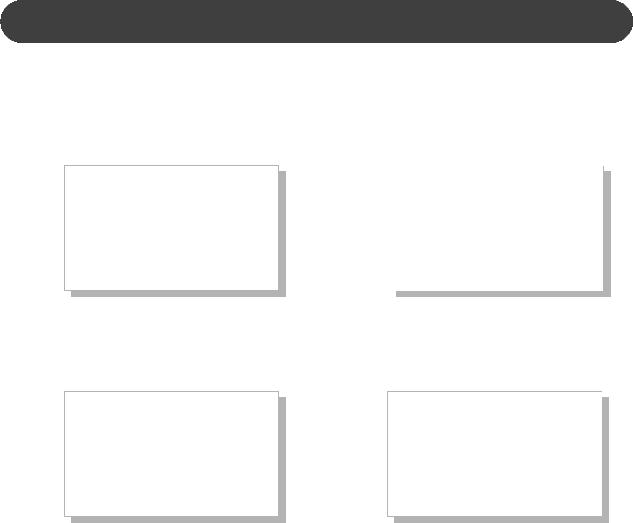
EASY SET UP AND QUICK PLAY
EASY SET UP AND QUICK PLAY IN FOUR SIMPLE STEPS
1 |
CHECK THE |
2 |
ASSEMBLE THE |
|
PACKAGE |
||||
PIANO STAND |
||||
|
CONTENTS |
|
|
3 |
PLACE THE PIANO |
4 |
TURN THE POWER |
|
SWITCH ON, |
||||
ON THE STAND, |
||||
ADJUST THE |
||||
ATTACH THE CABLES |
||||
|
|
VOLUME AND |
AND PLUG IN |
BEGIN TO PLAY |
|
7
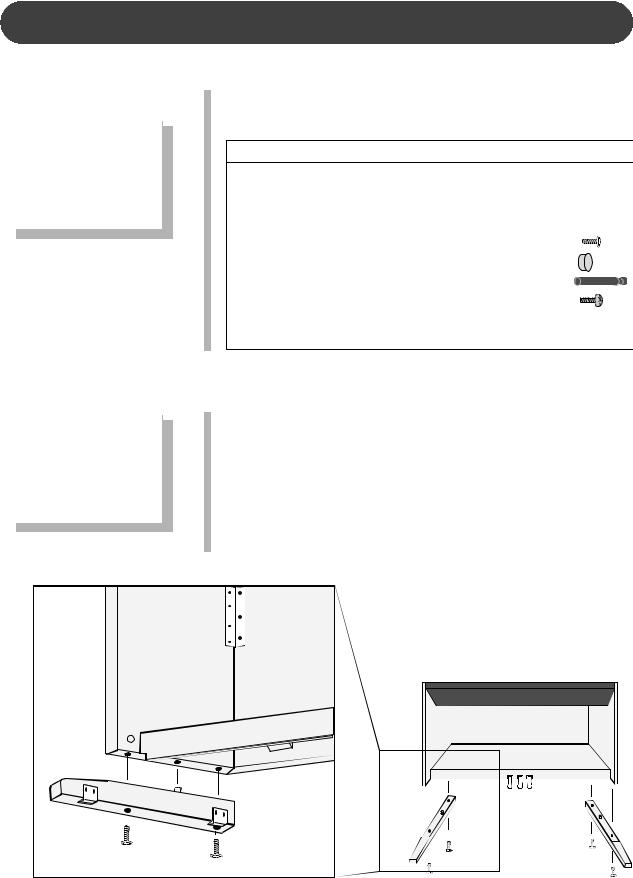
ASSEMBLY
1
CHECK THE
PACKAGE
CONTENTS
2
CHECK THE PACKAGE CONTENTS - Please make sure your package contains the following items prior to assembly.
AC POWER CORD ..................................... |
1 |
ASSEMBLE THE PIANO STAND
Please note, do all your final tightening only after the assembly has been completed.
ASSEMBLE THE PIANO STAND
1.Align each piano foot to the side of the piano pedal stand assembly by inserting the stub on the foot into the corresponding hole in the piano stand.
2.Insert the foot bolts up through the holes in the foot and into the stand, tighten.
8

ASSEMBLY
3
PLACE THE
PIANO
ON THE STAND,
PLACE THE PIANO ON THE STAND, ATTACH THE CABLES AND PLUG IN
1. Place the four metal piano support rods into the stand. Insert the support rod screws into the stand and tighten securely. Put the plastic screw covers into the holes in the piano stand legs.
9
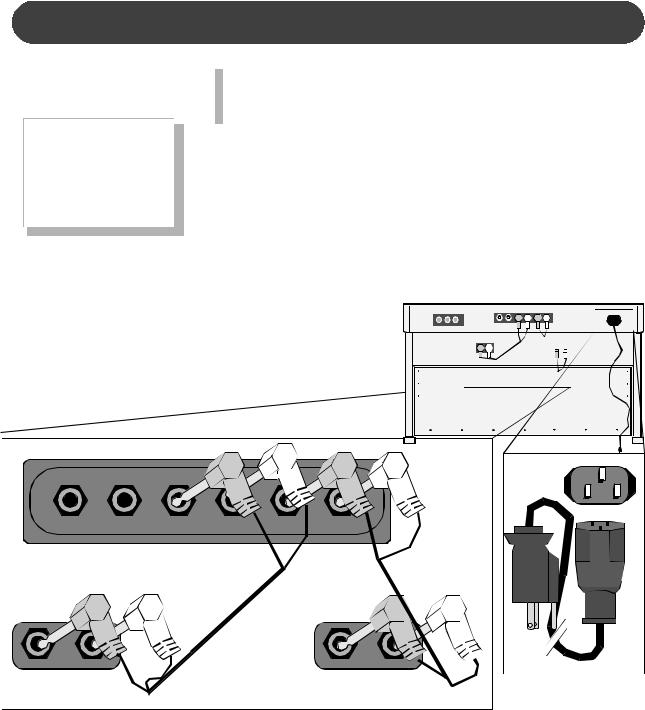
ASSEMBLY
3
ATTACH THE
CABLES
AND PLUG IN
2. Plug the pedal cable into its receptacle on the back of the piano. Plug the AC power cord into the “AC IN” jack, located on the back of the piano.
HP-275e
L


 SUZUKI
SUZUKI
10
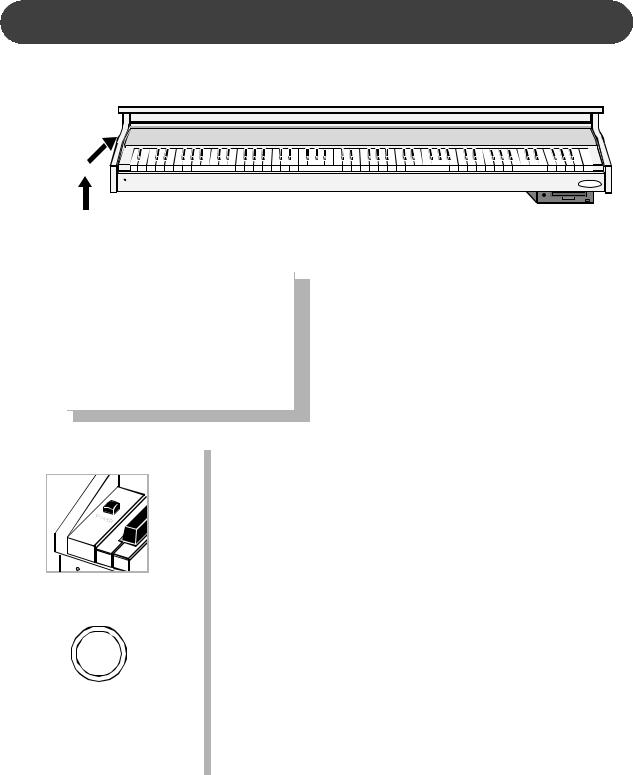
ASSEMBLY
Please note, to open the piano key cover gently lift up and then push inwards.
SUZUKI
4 |
TURN THE POWER |
SWITCH ON, |
ADJUST THE
VOLUME AND
BEGIN TO PLAY
1. TURN THE POWER SWITCH ON - Turn on the power switch located on the left side of the piano. The display will welcome you and set the instrument voice to Grand Piano automatically.
2. SET THE VOLUME TO THE DESIRED SETTING - Adjust the volume control to a comfortable level by turning the Master Volume control left, for softer sound or right, for louder sound.
MIN |
MAX |
MASTER VOLUME
3. BEGIN TO PLAY!
11
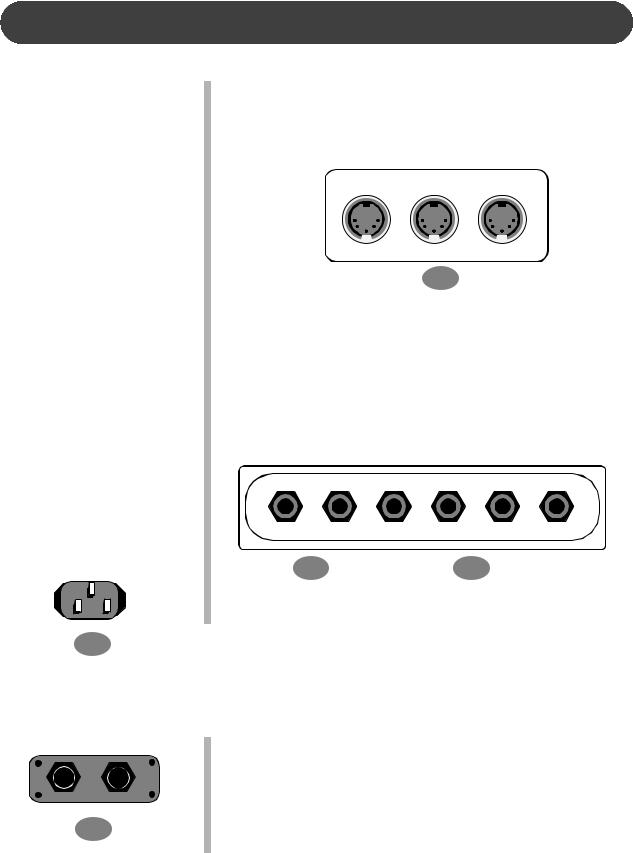
CONNECTOR PANELS
These connector jacks are located on the back of the piano.
1. MIDI OUT / MIDI IN / MIDI THRU - This piano contains MIDI in, MIDI thru and MIDI output ports. MIDI jacks allow communication with other products equipped with MIDI interfaces. Please see the MIDI section of this manual for further details.
MIDI
THRU |
OUT |
IN |
2. AUX IN - This stereo audio input 1 |
will amplify the supplied |
|
signal through the internal sound delivery system.
AUX OUT - This audio output jack supplies the piano’s output signal to external amplification.
3. AUX OUT 1 / AUX OUT 2 - These jacks are used to connect the pedal stand assembly to the piano. Please see the Assembly section of this manual for more information.
AUX IN AUX OUT |
AUX OUT 1 |
AUX OUT 2 |
||
|
R |
L |
R |
L |
2 |
|
|
3 |
|
4. A/C RECEPTACLE JACK - Plug the supplied A/C cord into this A/C Receptacle Jack
4
These headphone jacks are located directly under the piano on the left side of the piano.
5. PHONE 1 / PHONE 2 - You can play in total silence, without disturbing others in the room, by plugging a set of headphones into one of the appropriate sockets located on the left
side of the piano. When headphones are plugged into either of these jacks the main speaker system is turned off. Two sets of headphones may be used.
5
12

PANEL CONTROLS
|
|
|
BASS |
TREBLE |
MIC |
MIC |
BALANCE |
|
|
|
VOLUME |
ECHO |
|||
|
|
|
|
|
|
||
|
|
|
|
|
|
|
ACCMP |
|
|
|
|
|
|
|
MAX |
Composer En- |
|
MASTER VOLUME |
|
|
|
|
|
|
GENERAL |
MIN |
MAX |
|
|
|
|
semble |
|
|
1 |
|
|
|
KYBD |
|
|
|
|
|
|
||
HP-275e |
|
|
|
|
|
|
|
|
|
2 |
3 |
4 |
5 |
|
|
|
|
|
|
||||
This Suzuki piano’s control panel is simple and elegant. The following is a brief description of all the features located on the control panel.
POWER SWITCH - The power switch is located to the left of the
keys. Press the button to turn the power on and off. There is
an indicator on the left front piano portion of the piano that will
light when the power is turned on.
Please note, when you turn the power off, do not turn it back on immediately. Wait at least five seconds to turn the power back on so that the circuit can properly reset.
1.MASTER VOLUME - Turn this knob to the right to increase the overall volume of the piano, and to the left to decrease the volume.
2.BASS - Slide this controller to adjust the bass level. The midpoint is notched. At this mid-point all EQ controls are “flat.”
3.TREBLE - Slide this controller to adjust the treble level. The mid-point is notched. At this mid-point all EQ controls are “flat.”
4.MIC (MICROPHONE) VOLUME - Slide this controller to
adjust the volume of the microphone input jack for the optional microphone. Please see the Connector Panels section of this manual for more information.
5.MIC (MICROPHONE) ECHO - Slide this controller to adjust the echo or reverb effect on the microphone input jack for the optional microphone.
6.BALANCE - This sliding control will adjust the piano volume in
13
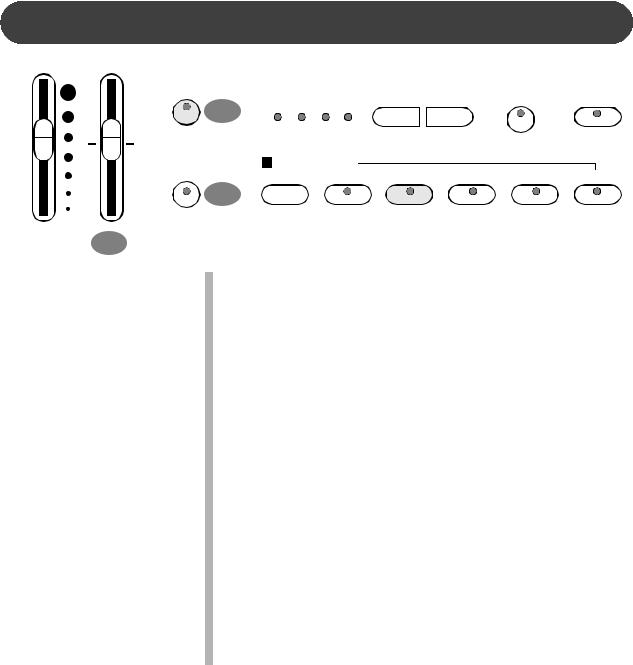
PANEL CONTROLS
MIC |
BALANCE |
|
|
|
|
|
|
ECHO |
|
|
|
|
|
|
|
|
|
|
|
|
|
|
|
|
ACCMP |
DEMO |
|
|
|
|
|
|
|
|
– TEMPO |
+ |
ONE TOUCH |
ACCOMP |
|
|
|
|
7 |
||||
|
|
|
|
|
|
|
|
|
MAX |
|
|
|
|
|
|
|
|
|
RHYTHM CONTROL |
|
|
|
|
|
|
SET UP |
SYNCH |
INTRO / END START / STOP |
FILL IN |
FILL TO VAR |
FADE |
|
KYBD |
|
8 |
|
|
|
|
|
|
|
|
|
|
|
|
|
6 |
|
|
|
|
|
|
conjunction with the accompaniment volume. Slide the controller up to increase the accompaniment volume and decrease the piano voice, slide the controller down to increase the piano voice and decrease the accompaniment volume.
7. DEMO (DEMONSTRATION) - Press the DEMO button. The first demo song will play back instantly. This piano has thirteen different demonstration songs designed to showcase the instrument’s capabilities. Please see the Demo section of this manual for more information.
There are also over 50 songs built into this piano to be used as reference for the Lesson exercises that can also be enjoyed. Please see the Lesson section of this manual for more information.
8.SET UP - The SET UP button is used to activate the set up menu screen. The majority of this pianos features and functions can be accessed and adjusted from the set up screen menu selections. Please see the Setup section of this manual for more information.
9.TEMPO - Press one of the TEMPO buttons, the current tempo
14

PANEL CONTROLS
MIC |
BALANCE |
9 |
|
10 |
11 |
ECHO |
|
||||
|
|
|
|
||
|
|
|
|
|
|
|
ACCMP |
|
|
|
|
|
|
– TEMPO |
+ |
ONE TOUCH |
ACCOMP |
|
MAX |
|
|
|
|
|
RHYTHM CONTROL |
|
|
|
|
|
SYNCH |
INTRO / END START / STOP |
FILL IN |
FILL TO VAR |
FADE |
KYBD
value will appear on the display. You can use the TEMPO +, TEMPO – buttons, or the +/– VALUE buttons to change the tempo value range from 40 to 240 bpm (beats per minute).
Press the – TEMPO or + TEMPO buttons or the +/– VALUE buttons simultaneously to recall the default tempo setting for the selected rhythm style.
LED Rhythm light bar display - There is a four-dot beat indicator to the left of the tempo buttons. It indicates the tempo and beat for the accompaniment that is playing. The lights flash simultaneously on the first beat of each measure, then the indicators flash individually in sequence on the remaining beats.
10.ONE TOUCH - The ONE TOUCH button will automatically select predetermined optimum piano settings for the selected rhythm style. The voice, voice volume, the fingered accompaniment chord, mode, harmony and effects will automatically be engaged or altered when one touch is selected.
11.ACCOMP (ACCOMPANIMENT) - Each of the rhythm styles have an auto accompaniment mode, often called the auto bass chord. These accompaniments are dedicated to the selected rhythm style, and will create fully orchestrated rhythm, bass and chord accompaniments, based on the
chord that you play with your left hand.
The ACCOMP button activates the chord select screen. With the accompaniment function engaged, the keys to the lleft side of the split point act as the auto accompaniment piano keys, while the keys to the right are available for normal playing. The auto accompaniment fingering modes are single, fingered and piano. Please see the Auto Accompaniment section of this manual for more information.
12. SYNC (SYNCHRONIZED START) - Synchronized Start
mode engages the auto accompaniment standby. Press the 15

PANEL CONTROLS
|
|
|
RHYTHM STYLES |
|
|
– TEMPO + |
ONE TOUCH |
ACCOMP |
R & B |
BIG BAND |
SWING |
RHYTHM CONTROL |
|
|
|
|
|
|
|
SYNCH |
INTRO / END START / STOP |
FILL IN |
FILL TO VAR |
FADE |
ACOUSTIC |
POP |
OLDIES |
12 13 14
SYNC button and the indicator lights beside the tempo buttons will flash to the beat of the selected rhythm style. The rhythm style will start as soon as you play in the auto accompaniment section of the piano.
The auto accompaniment will start with the first recognized chord played in the auto accompaniment section of the piano, depending on which fingering mode is selected.
13. INTRO/END (INTRODUCTION/ENDING PATTERN) - All of the 50 rhythm styles can be started with an appropriate introduction. As soon as you press this button, the rhythm of the introduction will start followed by the main pattern.
Each style also has an ending pattern.
The accompaniment can be ended with this pattern from the next measure by pressing the INTRO/ENDING button while the accompaniment is playing.
You can insert a fill-in during the ending to stop the ending and return to the main pattern.
14. START/STOP - This button starts and stops the selected rhythm style and/or the engaged auto accompaniment pattern.
This button will also start and stop a variety of features and functions throughout this piano.
15. FILL IN - This function provides the accompaniment with a short rhythm pattern of one or two measures for each style.
16
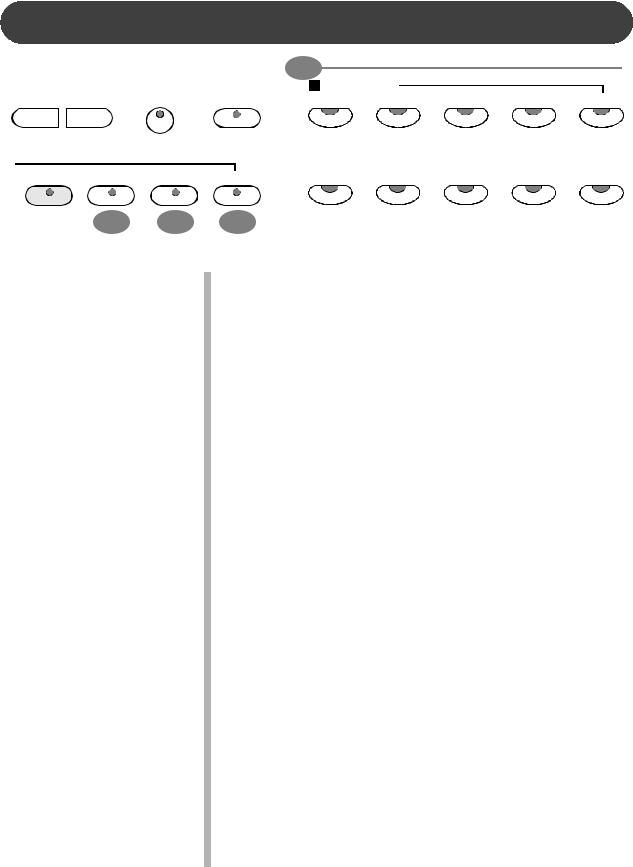
PANEL CONTROLS
18
|
|
|
RHYTHM STYLES |
|
|
|
|
– TEMPO + |
ONE TOUCH |
ACCOMP |
R & B |
BIG BAND |
SWING |
S. BALLAD |
RHUMBA |
START / STOP |
FILL IN |
FILL TO VAR |
FADE |
ACOUSTIC |
POP |
OLDIES |
ROCK |
LATIN |
15 16 17
Press the FILL IN button at any time while the accompaniment is playing.
If you hold down the FILL IN button, the fill-in pattern will repeat until the button is released, then the main pattern will play
from the beginning of the next measure.
16.FILL TO VAR (VARIATION) - All of the 50 rhythm styles include a variation of that style that can be played simply by engaging the FILL TO VAR button. If variation iis selected the engaged rhythm style will proceed to the variation rhythm pattern.
17.FADE - The FADE button allows the engaged rhythm style to fade in to full volume and fade out to the conclusion. When the fade out has finished the LED will flash while the previously set volume levels are being restored.
Pressing the FADE button after it has already been engaged will switch the fade feature off.
The fade in and fade out time is assignable in the setup menu screen “performance”.
18.QUICK SELECT RHYTHM STYLES - There are ten styles that can be selected quickly by pressing one of the ten quick select RHYTHM STYLE buttons. The style name is printed above the style select button. The style name and its number
will be shown on the display.
Press the RHYTHM STYLE button again to engage a rhythm select screen. Each button accesses related styles in one or two groups.
Please see the Rhythm section of this manual for more information.
19. CURSOR - The CURSOR button group allows you to access and highlight different areas within the display screen, espe-
17
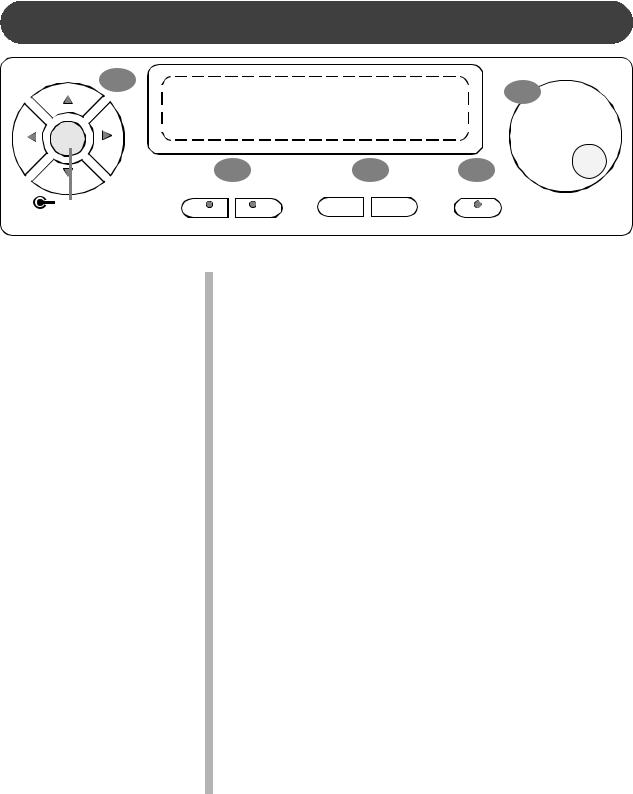
PANEL CONTROLS
CURSOR |
19 |
|
|
23 |
|
|
|
20
SCREEN |
|
VALUE |
ENTER |
ESCAPE |
|
|
|
LEFT RIGHT |
– |
|
+ |
|
|
|
cially while in the Setup mode.
ESCAPE - The ESCAPE button will return the current display screen to the previous screen.
Continue pressing this button to return to the original default performance screen.
20.SCREEN LEFT, SCREEN RIGHT - The SCREEN buttons are used to access different pages within a display screen. If an indicator light is on, there is additional screen information available for the selected function. Use the SCREEN LEFT or SCREEN RIGHT buttons to access the menu page that you want to view.
21.VALUE - Use the VALUE + and - buttons to adjust levels on the currently selected feature. These buttons auto repeat when they are held down.
The default setting of the selected parameter can be recalled by pressing down both the VALUE + and - buttons at the same time.
22.ENTER - Use the enter button to select your highlighted function or feature.
23.VALUE WHEEL - Use the value wheel as an alternative method to change the value of the selected feature. To increase the value turn the wheel clockwise, to decrease the value turn the wheel counterclockwise.
24.UPPER - This button is used to select the voice for the upper
18

PANEL CONTROLS
|
|
SOUND GROUP |
|
|
|
|
|
|
UPPER |
GRAND PIANO |
PIANO |
VIBES |
ORGAN |
GUITAR |
BASS |
VIOLIN |
STRINGS |
24 |
|
27 |
|
|
|
|
|
|
LAYER |
REVERB |
SAXOPHONE |
FLUTE |
SYNTH LEAD |
SYNTH |
SYNTH FX |
BANJO |
STL.DRUM |
25 |
|
|
|
|
|
|
|
|
|
|
REGISTRATION MEMORY |
|
|
|
|
|
|
LOWER |
EFFECTS |
STORE |
1 |
2 |
3 |
4 |
5 |
6 |
26
mode and engages the selected voice for all 88 piano keys. Please see the Piano Voices section of this manual for more information.
25.LAYER - Engaging the LAYER button will put the piano in the layer, or dual mode. Layer refers to an additional voice that is tone mixed with the selected upper voice.
Please see the Piano Voices section of this manual for more information.
26.LOWER - With the LOWER feature engaged the piano operates in the split mode. In the split mode the piano is divided into two sections. In the right hand section the upper or the layered voice will sound, and in the left hand section a different voice can be selected to sound when the keys are played. Please see the Piano Voices section for more information.
27.GRAND PIANO - This button will reset the piano to its default (power up) settings while engaging the Grand Piano voice for all 88 keys.
28.REVERB - The reverb effect is engaged automatically when the power is turned on. Reverb simulates the effect of play-
19
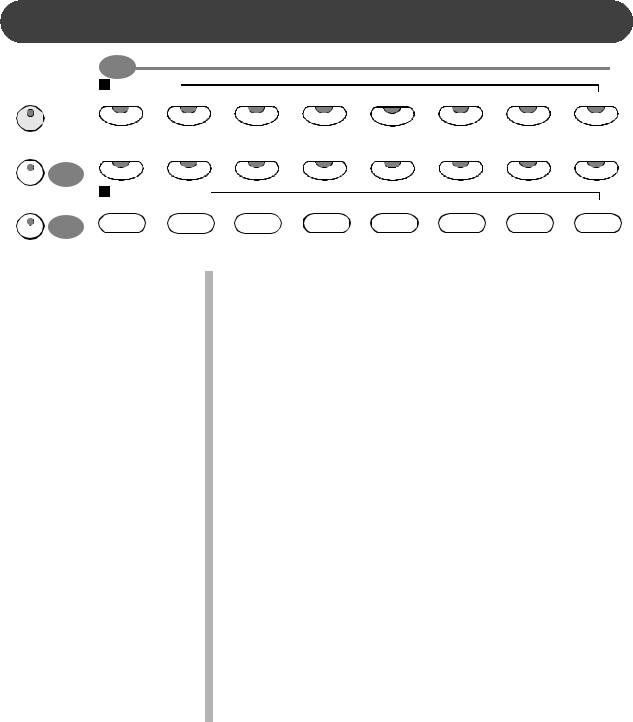
PANEL CONTROLS
30
|
SOUND GROUP |
|
|
|
|
|
|
|
GRAND PIANO |
PIANO |
VIBES |
ORGAN |
GUITAR |
BASS |
VIOLIN |
STRINGS |
TRUMPET |
REVERB |
SAXOPHONE |
FLUTE |
SYNTH LEAD |
SYNTH |
SYNTH FX |
BANJO |
STL.DRUM |
SOUND FX |
|
28 |
|
|
|
|
|
|
|
|
REGISTRATION MEMORY |
|
|
|
|
|
|
|
EFFECTS |
STORE |
1 |
2 |
3 |
4 |
5 |
6 |
BANK |
29
ing in a big room or hall where the sound reverberates off the walls and ceiling. Press the REVERB button to turn off the reverb effect, its indicator LED will turn off.
Reverb depth can be changed in the setup menu “Reverb”. Please see the Setup section for more information.
29. EFFECTS - The EFFECTS button will add chorus, flanger or delay effects to the selected instrument voice on the piano. There are eight DSP (Digital Signal Processing) effects available.
Use the setup menu “Effects” selection to change the effect. Please see the Setup section of this manual for more information.
30.(QUICK SELECT VOICE) SOUND GROUP - There are sixteen voices that can be selected quickly by pressing one of the voice select buttons. The voice name and its number will be shown on the display. To see a voice menu press the same voice button again. Each button accesses a group of eight related voices in two groups for a total of 128 GM voices. Please see the Piano Voices section of this manual for more information.
31.STORE - The STORE button engages the registration memory feature. Registration is used to save piano settings of rhythm, voice, accompaniment, and other features you
20
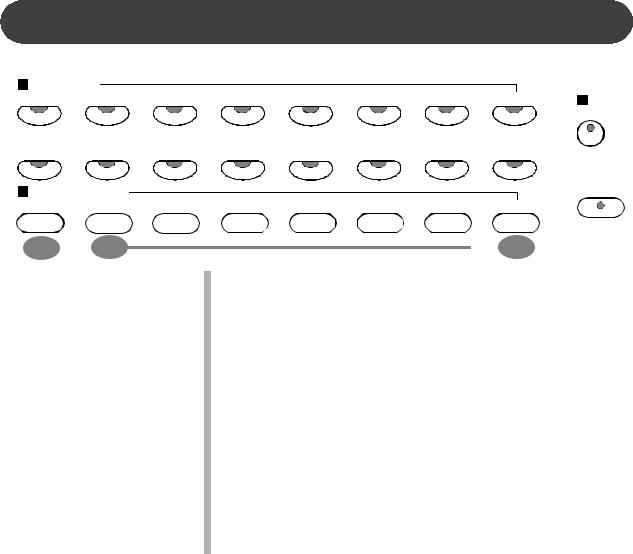
PANEL CONTROLS
SOUND GROUP |
|
|
|
|
|
|
|
|
PIANO |
VIBES |
ORGAN |
GUITAR |
BASS |
VIOLIN |
STRINGS |
TRUMPET |
COMPOSER |
|
|
|
|
|
|
|
|
|
|
|
|
|
|
|
|
|
ACCOMP |
SAXOPHONE |
FLUTE |
SYNTH LEAD |
SYNTH |
SYNTH FX |
BANJO |
STL.DRUM |
SOUND FX |
|
REGISTRATION MEMORY |
|
|
|
|
|
|
PLAY/PAUSE |
|
|
|
|
|
|
|
|
||
STORE |
1 |
2 |
3 |
4 |
5 |
6 |
BANK |
|
31 |
32 |
|
|
|
|
|
33 |
|
have engaged. The piano has four banks each with six registrations for a total of 24 registration memories. Please see the Registration Memory section of the manual for more information.
32.REGISTRATION NUMBER BUTTONS - Use the registration number buttons 1-6 to save or recall a setting in the registration memory.
33.BANK - There are four registration banks, A, B, C and D. Press the BANK button to cycle through these banks. Please see the Registration Memory section of this manual for more information.
34.ACCOMP (ACCOMPANIMENT) - The ACCOMP button is used to select the auto accompaniment track for recording or playback.
21
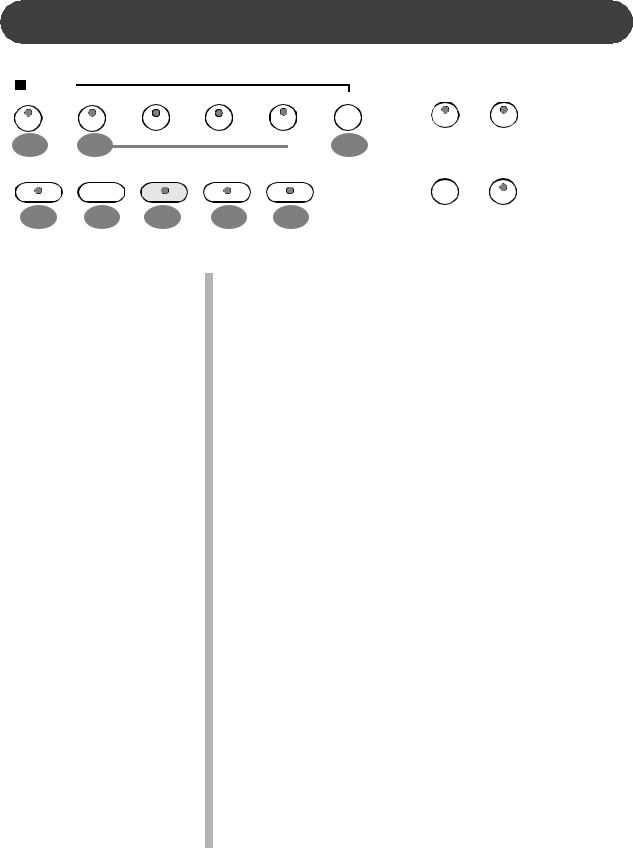
PANEL CONTROLS
COMPOSER |
|
|
|
|
|
DISK |
METRONOME |
|
ACCOMP |
MEL. 1 |
MEL. 2 |
MEL. 3 |
MEL. 4 |
RESET |
|||
|
|
34 |
35 |
|
|
|
36 |
|
PLAY/PAUSE |
STOP |
RECORD |
BEG. MARK |
MARK |
MIDI |
SONG |
|
|
|||||
37 |
38 |
39 |
40 |
41 |
|
|
35.MEL (MELODY) 1-4 - There are four tracks for recording melody, which are assigned by the MELODY 1-4 buttons.
36.RESET - The RESET button is used to erase a previously recorded track.
37.PLAY/PAUSE - Press the PLAY/PAUSE button to hear previously recorded tracks. Press the PLAY/PAUSE button again to pause the recording or playback.
38.STOP - Press the STOP button to stop the recording or playback.
39.RECORD - This contains a 5-track sequencer (recorder), that allows the user to record their music performances. It can record all note events exactly as they are performed.
When the RECORD button is pressed it puts the selected
tracks into the record standby mode.
Recording begins as soon as you start to play on any section of the piano. Please see the Record section of the manual for more information.
40. |
BEG (BEGIN) MARK - Use this button to mark the beginning |
|
of a recorded passage. You can use this feature to isolate |
|
part of a recording for listening or embellishment. |
41. |
END MARK - Use this button to mark the end of the recorded |
|
section you wish to isolate. |
42. |
DISK - The DISK button toggles the disk menu screen on and |
|
off. Please see the Disk section of this manual for more |
22 |
information. |

PANEL CONTROLS
MEL. 2 |
MEL. 3 |
MEL. 4 |
RESET |
DISK |
METRONOME |
42  43
43
RECORD |
BEG. MARK |
MARK |
MIDI |
SONG |
|
|
|
44 |
45 |
43.METRONOME - The METRONOME button toggles the metronome feature on and off and accesses the Metronome menu. The tempo can be increased or decreased using the TEMPO + and - buttons.
Please see the Setup section of this manual for more information.
44.MIDI - MIDI is an abbreviation for Musical Instrument Digital Interface. The MIDI features in this piano are capable of communicating with and/or controlling other MIDI devices. Please see the MIDI section of this manual for more information.
45.SONG - Use the SONG button to access the music Lesson program and the Song Select screen. This “music teacher” feature can be used as an aid to learn the more than 50 songs built into this piano. The SONG button turns the music teacher on and off. Please see the Lesson section of this manual for more information.
23
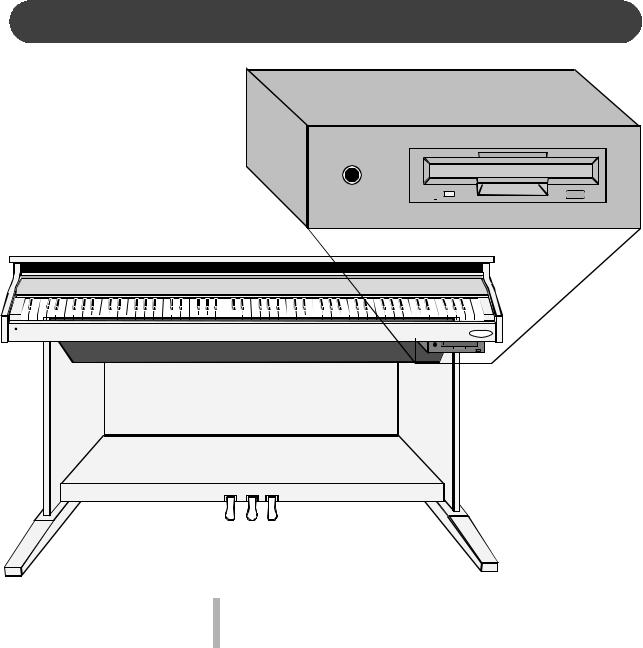
DISK DRIVE
SUZUKI
DISK DRIVE - The disk drive is located under the piano keys on the right hand side of the unit. It is used to drive a floppy diskette. Please see the Disk section of this manual for more information.
24
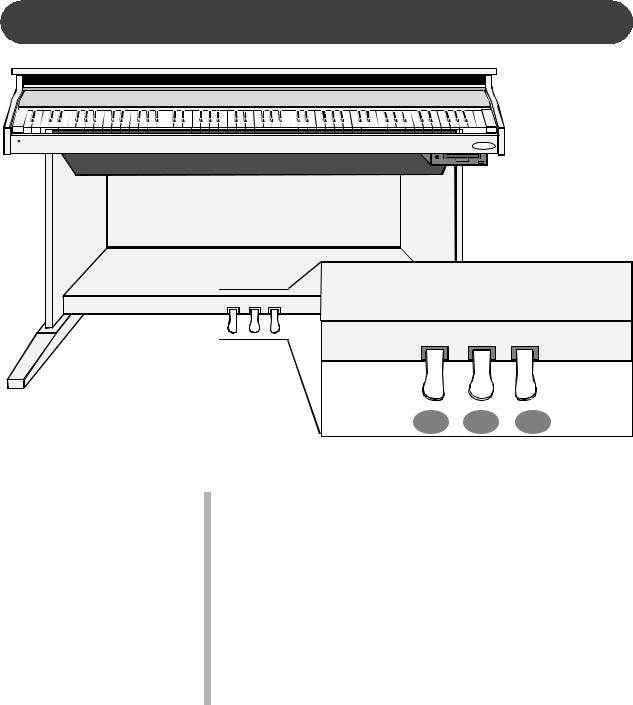
PEDALS
SUZUKI
1 2 3
PEDALS
1.SOFT PEDAL - When the left pedal is engaged the piano volume is reduced and the timbre slightly altered on the notes that are played.
2.FUNCTION PEDAL - This center pedal can be used to trigger various events, such as start/stop. Pedal function is assigned in the setup menu, “Pedal Assign”. Please see the Setup section of this manual for more information.
3.SUSTAIN PEDAL - When the right pedal is engaged all volumes of the keys as they are played will decay gradually as if you were continuing to hold down the piano keys.
25

DISPLAY SCREEN
1 |
CURSOR |
6 |
|
|
2 |
3 |
|
4 |
5 |
SCREEN |
|
VALUE |
ENTER |
|
|
|
|||
ESCAPE |
|
|
|
|
|
LEFT RIGHT |
– |
|
+ |
|
|
|
|
This screen displays the various Setup menus and performance screens.
1.Use the CURSOR keys to select the portion of the screen that you wish to manipulate. The portion of the screen that is selected will be highlighted.
2.The ESCAPE button in the middle of the cursor controls will return the current display screen to the previous screen. Continue pressing this button to return to the initial performance screen.
3.The Left and Right SCREEN buttons will move the display to additional pages within the selected menu. The indicator will be lit if there is additional screen information available.
4.Use the VALUE buttons to adjust the value on the selected menu item.
5.Use the ENTER button to engage a highligted selection.
6.The VALUE wheel can be used as an alternative to the VALUE buttons.
The default performance screen shows:
The instrument |
UPPER 1 : Grand Piano |
voice |
STYLE 1 : R & B
NC A1
The currently selected voice number and name. Since this area is highlighted it is selected and available for changes.
|
The currently se- |
/ = 100 |
lected style number |
and name. |
Auto Accompaniment: When auto accompaniment is engaged, this area shows the chord that is playing.
(NC = no chord)
The current tempo.
Registration: The current bank (A) and registration number (1).
26
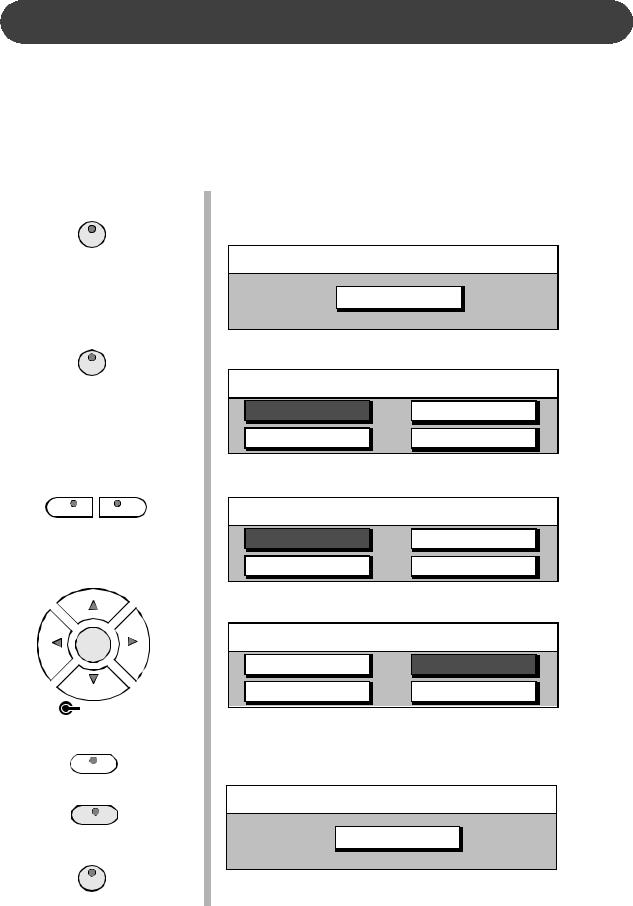
DEMO
PLAYING THE DEMO SONGS - This piano has thirteen different demonstration songs that are designed to showcase the different sampled voices that are available. The display will show the song name. All the songs will play back repeatedly until the demonstration is stopped.
There are over 50 songs in the musical Lesson course that can also be played back as a demonstration. Please see the Lesson section of this manual for more information.
DEMO
DEMO
SCREEN
SELECT AND PLAY A DEMO SONG -
1. Press the DEMO button, the indicator will go on. The first demo song will playback instantly. This unit has thirteen demonstration songs.
DEMO
Bossa Nueva
2. Press the DEMO button again to access the Demo Song Select menu.
Demo Song Select
Bossa Nueva |
Mozart Piano |
Vibra Jazz |
String Riot |
3. Use the SCREEN RIGHT or SCREEN LEFT buttons to access different pages within the Demo Song Select menu.
LEFT RIGHT
CURSOR
ESCAPE
ENTER
START / STOP
DEMO
Demo Song Select
Samba Time |
Bach F minor |
Spanish Vibe |
Symphonic |
4. Use the CURSOR buttons to move the highlighted area to the song you wish to hear.
Demo Song Select
Samba Time |
Bach F minor |
Spanish Vibe |
Symphonic |
5. Press the ENTER button to confirm your selection. Your selected song will playback instantly. The song will play repeatedly until you press the START/STOP button to stop the song.
|
DEMO |
|
Bach F minor |
6. |
mode, |
|
the indicator will turn off. |
27
